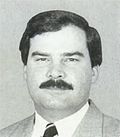| Representative | Party | Service | Cong
ress(es) | Electoral history | Location |
|---|
| District created March 4, 1837 |
Lancelot Phelps
(Hitchcockville) | Democratic | March 4, 1837 –
March 3, 1839 | 25th | redistricted from the at-large district and re-elected in 1837.
Retired. | |

Truman Smith
(Litchfield) | Whig | March 4, 1839 –
March 3, 1843 | 26th
27th | Elected in 1839.
Re-elected in 1840.
Retired. |
| District eliminated following the 1840 census |
| District organized from Connecticut's at-large congressional district in 1913 |

William Kennedy
(Naugatuck) | Democratic | March 4, 1913 –
March 3, 1915 | 63rd | Elected in 1912.
Lost re-election. | |

James P. Glynn
(Winsted) | Republican | March 4, 1915 –
March 3, 1923 | 64th
65th
66th
67th | Elected in 1914.
Re-elected in 1916.
Re-elected in 1918.
Re-elected in 1920.
Lost re-election. |

Patrick B. O'Sullivan
(Derby) | Democratic | March 4, 1923 –
March 3, 1925 | 68th | Elected in 1922.
Lost re-election. |

James P. Glynn
(Winsted) | Republican | March 4, 1925 –
March 6, 1930 | 69th
70th
71st | Elected in 1924.
Re-elected in 1926.
Re-elected in 1928.
Died. |
| Vacant | March 6, 1930 –
November 4, 1930 | 71st | |
Edward W. Goss
(Waterbury) | Republican | November 4, 1930 –
January 3, 1935 | 71st
72nd
73rd | Elected to finish Glynn's term.
Re-elected in 1930.
Re-elected in 1932.
Lost re-election. |

J. Joseph Smith
(Prospect) | Democratic | January 3, 1935 –
November 4, 1941 | 74th
75th
76th
77th | Elected in 1934.
Re-elected in 1936.
Re-elected in 1938.
Re-elected in 1940.
Resigned when appointed Judge of the U.S. Court of Appeals. |
| Vacant | November 4, 1941 –
January 20, 1942 | 77th |

Joseph E. Talbot
(Naugatuck) | Republican | January 20, 1942 –
January 3, 1947 | 77th
78th
79th | Elected to finish Smith's term.
Re-elected in 1942.
Re-elected in 1944.
Retired to run for Governor of Connecticut. |

James T. Patterson
(Watertown) | Republican | January 3, 1947 –
January 3, 1959 | 80th
81st
82nd
83rd
84th
85th | Elected in 1946.
Re-elected in 1948.
Re-elected in 1950.
Re-elected in 1952.
Re-elected in 1954.
Re-elected in 1956.
Lost re-election. |

John S. Monagan
(Waterbury) | Democratic | January 3, 1959 –
January 3, 1973 | 86th
87th
88th
89th
90th
91st
92nd | Elected in 1958.
Re-elected in 1960.
Re-elected in 1962.
Re-elected in 1964.
Re-elected in 1966.
Re-elected in 1968.
Re-elected in 1970.
Lost re-election. |

Ronald A. Sarasin
(Beacon Falls) | Republican | January 3, 1973 –
January 3, 1979 | 93rd
94th
95th | Elected in 1972.
Re-elected in 1974.
Re-elected in 1976.
Retired to run for Governor of Connecticut. |

William R. Ratchford
(Danbury) | Democratic | January 3, 1979 –
January 3, 1985 | 96th
97th
98th | Elected in 1978.
Re-elected in 1980.
Re-elected in 1982.
Lost re-election. |

John G. Rowland
(Waterbury) | Republican | January 3, 1985 –
January 3, 1991 | 99th
100th
101st | Elected in 1984.
Re-elected in 1986.
Re-elected in 1988.
Retired to run for Governor of Connecticut. |

Gary Franks
(Waterbury) | Republican | January 3, 1991 –
January 3, 1997 | 102nd
103rd
104th | Elected in 1990.
Re-elected in 1992.
Re-elected in 1994.
Lost re-election. |

James H. Maloney
(Danbury) | Democratic | January 3, 1997 –
January 3, 2003 | 105th
106th
107th | Elected in 1996.
Re-elected in 1998.
Re-elected in 2000.
Lost re-election. |

Nancy Johnson
(New Britain) | Republican | January 3, 2003 –
January 3, 2007 | 108th
109th | Redistricted from the 6th district and re-elected in 2002.
Re-elected in 2004.
Lost re-election. | 2003–2013  |

Chris Murphy
(Cheshire) | Democratic | January 3, 2007 –
January 3, 2013 | 110th
111th
112th | Elected in 2006.
Re-elected in 2008.
Re-elected in 2010.
Retired to run for U.S. Senator. |

Elizabeth Esty
(Cheshire) | Democratic | January 3, 2013 –
January 3, 2019 | 113th
114th
115th | Elected in 2012.
Re-elected in 2014.
Re-elected in 2016.
Retired. | 2013–2023  |

Jahana Hayes
(Wolcott) | Democratic | January 3, 2019 –
present | 116th
117th
118th
119th | Elected in 2018.
Re-elected in 2020.
Re-elected in 2022.
Re-elected in 2024. |
2023–present  |





















